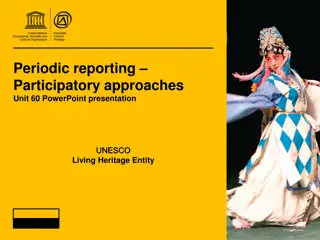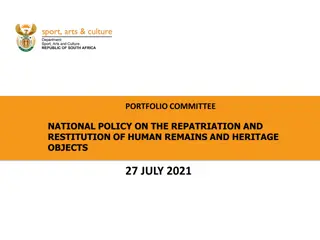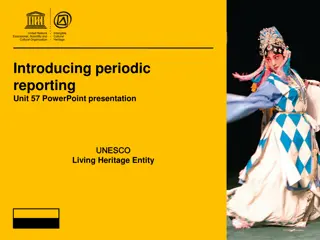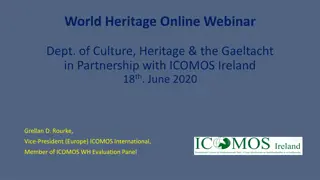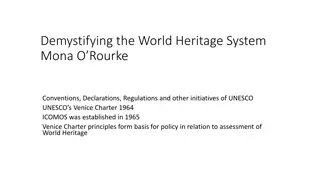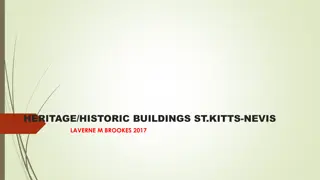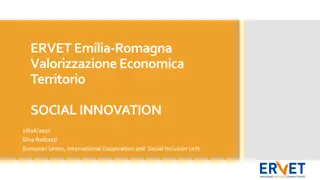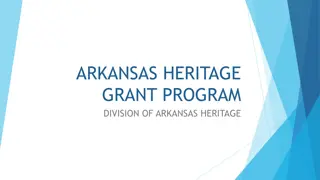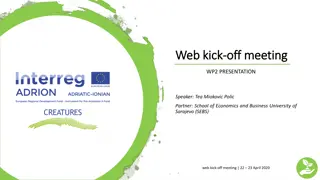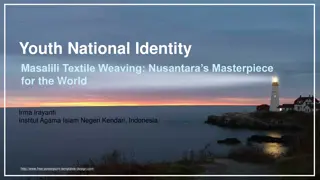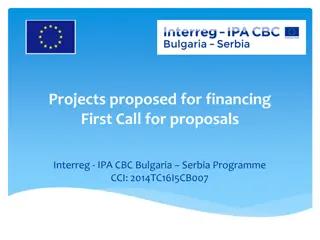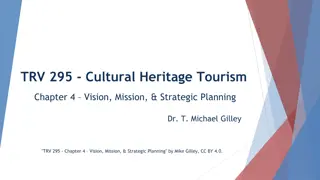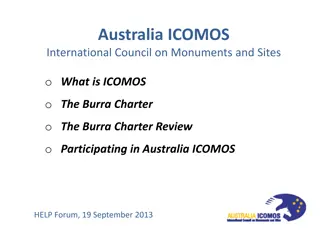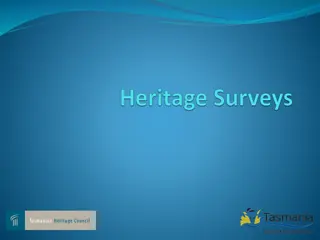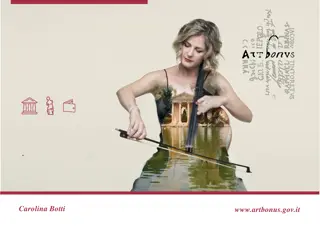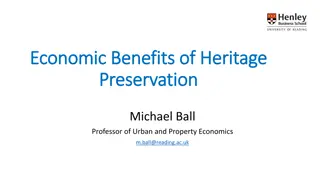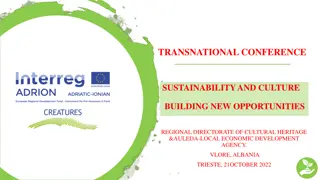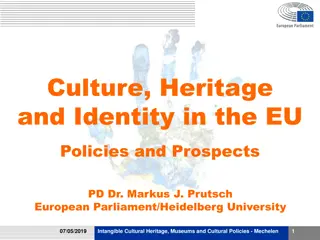Cultural Heritage as an Engine for Innovation and Growth in the Region of Lazio
Discussing the significance of cultural heritage in driving innovation and growth in the Region of Lazio, this report highlights the key elements and issues related to smart specialization strategies. It emphasizes the economic impact of tourism and cultural heritage in terms of enterprises, value added, employees, and international tourism, showcasing the region's rich cultural assets. The report also mentions the presence of archaeological parks, monuments, museums, UNESCO sites, universities, and research organizations, underlining the importance of preserving and leveraging cultural heritage for community access and development.
Uploaded on Nov 13, 2024 | 1 Views
Download Presentation

Please find below an Image/Link to download the presentation.
The content on the website is provided AS IS for your information and personal use only. It may not be sold, licensed, or shared on other websites without obtaining consent from the author.If you encounter any issues during the download, it is possible that the publisher has removed the file from their server.
You are allowed to download the files provided on this website for personal or commercial use, subject to the condition that they are used lawfully. All files are the property of their respective owners.
The content on the website is provided AS IS for your information and personal use only. It may not be sold, licensed, or shared on other websites without obtaining consent from the author.
E N D
Presentation Transcript
CULTURAL HERITAGE An engine for innovation and growth S3 Platform peer review Rome, 25th November2016 Implementing Smart Specialisation Strategies: how do we address Cultural Heritage and what are the key issues in addressing Cultural Heritage? REGION of LAZIO
CULTURAL HERITAGE. An engine for innovation and growth S3 Platform peer review (Rome, 25th November 2016) Tourism and cultural heritage - Our region by the numbers Number of enterprises: 40,000 (14% of the national total) Source: Io sono cultura - 2016 Value added: 14,700,000,000 (16% of the national total) Source: Io sono cultura - 2016 Number of employees: 202,000 (14% of the national total) International tourism totals: 20,000,000 visitors 6,300,000,000 (3.8% of the national total) Source: Banca d Italia Source: Io sono cultura - 2016
CULTURAL HERITAGE. An engine for innovation and growth S3 Platform peer review (Rome, 25th November 2016) Cultural heritage - Our region by the numbers Archaeological parks & areas: 28 Monuments: 29 Museums and galleries: 259 UNESCO: 5 Source: Istat - 2011 Universities: 13 Central institutions of the Ministry of Cultural Heritage and Activities and Tourism (MiBACT): 6 (5 public and 8 private) Source: MIUR 2015 Leading Research Organizations: 3 (ENEA, CNR, INFN)
CULTURAL HERITAGE. An engine for innovation and growth S3 Platform peer review (Rome, 25th November 2016) S3 elements relevant to the Cultural Heritage of the Region of Lazio A first-rate industry, recognized worldwide, which includes all sectors connected with the development of knowledge, products and services related to the various links in the value chain: Knowledge, diagnostics, conservation and restoration necessary to explore and preserve Cultural Heritage; Development, use and management of Cultural Heritage assets to present them and make them accessible to the community.
CULTURAL HERITAGE. An engine for innovation and growth S3 Platform peer review (Rome, 25th November 2016) S3 elements relevant to the Cultural Heritage of the Region of Lazio 1) Strong presence of public operators and market failure 2) Conditions for improving competitiveness: the removal of institutional constraints and national laws that restrict the development of innovation, and tax incentives to facilitate private financing; the implementation of new technologies for diagnosis, planning, restoration and safeguarding of cultural heritage assets, including imported from other sectors (cross fertilization), in particular from aerospace and ICT; the use of technology and development of new technological products for the marketing and commercial exploitation phase (laser scans, 3D models, apps, etc.); strengthening the way the territory markets museums, to make viewing them interactive and exciting for visitors, drawing inspiration from the most successful examples throughout Europe
CULTURAL HERITAGE. An engine for innovation and growth S3 Platform peer review (Rome, 25th November 2016) Past actions Consultation with stakeholders (listening and feedback): New industry policy "Value added Lazio" Milestones DRAFTING OF THE NEW PUBLIC NOTICE "Exploitation, use and conservation of cultural assets " worth 10.6 million Guidance for the design and implementation of public notices Focus group Focus group Overall State of the Industry Call 4 Proposals September October 2016 2017 24-26 February 2016 16 December 2013 28 July 2015 Timeline
CULTURAL HERITAGE. An engine for innovation and growth S3 Platform peer review (Rome, 25th November 2016) Past actions Consultation with stakeholders (listening and feedback): Call 4 Proposals Area of the actor making the proposal Total Investments: 256,695,000 Average investment: 9,507,222 Number of proposals 27 2 3 By residence of the actor making the proposal 15 Multi-sector 3 5% 1% - FR 33% RI 24% ICT, Elettronica e Smart cities RM Regional level proposals: 2 Proposals not at the regional level: 2 VT Agrifood Lazio 0% Circular economy e Energia 37% Scienze della vita e Farmaceutico Altro
CULTURAL HERITAGE. An engine for innovation and growth S3 Platform peer review (Rome, 25th November 2016) Lessons learned Consultation with stakeholders (listening and feedback): Focus group (16 December 2013) - Smart Specialization Strategy Lazio Focus Group Cultural Heritage: High number and quality of consultations, and identification of seven S3 priority areas, including "Cultural Heritage and Technology for Culture" Strengthening listening and feedback activities Call for Proposals (published 28 July 2015): Formalization of 8 Areas of interest for implementation of public notices relating to S3 areas of specialization for a total value of over 100 million (including the public notice "Exploitation, use and conservation of cultural assets" with a value of 10.6 million) Limiting the duration of the process of drafting public notices (high number of proposals received) Active participation by numerous stakeholders: 12 focus groups with nearly 1,000 participants, including about 150 in the focus group on "Cultural heritage and technology for culture" Overall State of the Industry (22-24 February 2016): Strengthening and continuity in the dialogue with stakeholders
CULTURAL HERITAGE. An engine for innovation and growth S3 Platform peer review (Rome, 25th November 2016) Past actions Local actions for Cultural Heritage The Technological District for Culture DTC1 (2009-2014) DTC1: the Technology District for cultural heritage and activities was created in May 2008 through a "Framework Programme Agreement" between the Region of Lazio, the Ministry of Economic Development, the Ministry of Education, Universities and Research and the Ministry of Cultural Heritage and Activities and Tourism, as a tool for economic and local development, to initiate a structured network of relationships and technical/scientific collaborations between public and private research and businesses. The DTC's implementing measures made it possible to create an integrated system of 10 projects, beginning in 2009 and concluding in 2014, through 5 regional public notices worth a total of 13 million euro, for the purpose of enhancing Lazio's cultural heritage and to consolidate and stimulate innovation on the part of sector stakeholders.
CULTURAL HERITAGE. An engine for innovation and growth S3 Platform peer review (Rome, 25th November 2016) Lessons learned Local financial actions exclusively for Cultural Heritage DTC1 - Technology District for cultural heritage and activities (2009-2014): Exporting (Malaysia and Taiwan) the DTC model abroad More Heritage s owners to be developed in the design, implementation and maintenance of the technology created empowerment of the Cultural 10
CULTURAL HERITAGE. An engine for innovation and growth S3 Platform peer review (Rome, 25th November 2016) 2014-2020 POR (Regional Operational Plan) priorities, actions and financial resources OT (Objective) 1 - Research, technological development and innovation / Axis 1 Research and Innovation Total resources allocated: 180 Million Resources for Technologies for Cultural Heritage (in millions of ) 5 Total OT priority Action Planned actions RESOURCES (in millions of ) Enhancing the infrastructrure for research and innovation (R&I) and the capacities for developing excellence in R&I and promoting centres of competence, in particular those of European interest; Infrastructural strengthening of regional technology clusters and research facilities 20 Support for infrastructure for research considered critical or crucial to the region's systems Strengthening of private competence centres in the region Support for research, innovation and the transfer of technology from research to enterprises and among sectors and for the development of consortia and business networks Realization of strategic projects 3.8 15 Support for the economic promotion of innovation through experimentation and adoption of innovative solutions in processes, products and organizational formulas [...] 5 40 9.2 0.4 70 Support for collaborative R&D activities for the development of new sustainable technologies, new products and services [...] Actions to support R&I cooperation within and beyond the region and promotion of local results 3 Promoting business investment in R&I by developing links and synergies between businesses, centres of research and development centers and the higher education sector.... System-wide actions to support the participation of local actors in the consultative platforms and national technological specialization networks such as the National Technological Clusters, and projects financed by other European research and innovation programmes (such as Horizon 2020) Strengthening and improving the PA's demand for innovation by supporting Precommercial Public Procurement and Innovation Procurement actions. Support for the creation and consolidation of innovative start-ups involving intensive application of knowledge and of research spin-off initiatives [...] Support for entrepreneurial projects submitted under European R&D programmes 0.3 2 Strengthening and improving the demand for PA innovation 5 10 1 Support for highly technological startups and spin-offs 20 29.7 180
CULTURAL HERITAGE. An engine for innovation and growth S3 Platform peer review (Rome, 25th November 2016) 2014-2020 POR (Regional Operational Plan) priorities, actions and financial resources OT 3 To promote the competitiveness of SMEs, the agricultural sector and the fisheries and aquaculture sector Axis 3 Competitiveness Total resources allocated: 169.4 million Resources for Technology for Cultural Heritage (in millions of ) Total resources (in millions of ) OT priority Action Planned actions Projects to promote exports, aimed at companies and groups of companies identified by territory or sector [...] To develop and implement new business models for SMEs, in particular for internationalization 5 81 Internationalization of the sector Strengthening of the system of public guarantees for credit expansion in synergy between the national and regional guarantee systems [...] Guarantees and access to credit To support SMEs' capacity to grow on regional, national and international markets and to take part in the processes of innovation; 7 Promotion and support for the use of innovative bond financing for SMEs (e.g. Minibonds) 88.4 Innovative bond financing Contribution to the development of the market of venture capital funds for pre-seed, seed and early stage business startups Venture Capital Fund 12 169.4
CULTURAL HERITAGE. An engine for innovation and growth S3 Platform peer review (Rome, 25th November 2016) 2016-2020 APQ6 (Framework Programme Agreement) financial measures and resources "Research, technological innovation, telecommunications networks" excerpt from "Implementation of plan actions and new measures for technological district for new technology for cultural heritage and activities" IV Supplementary agreement Resources for Technology for Cultural Heritage (in millions of ) Action TE1 - Centre for Excellence consisting of Registry of Skills and Centre for Spreading Regional Innovation for Materials and Technology intended in part to promote high-quality artistic handicrafts 6 23.2 TE2 - Actions for research and development of technologies for the development, protection, use, conservation, recovery and sustainability of cultural heritage TE3: Actions for capital for companies that propose to carry out highly technological and innovative activities that require launching processes of technological renewal and improvement of the process and/or product, including in partnership with private investors 3 6 TE4: Actions for research and development of new technologies and methodologies for better enjoyment of the performing arts (music, theatre and dance) 3.5 TE5: Communication, promotion and support for the processes that promote the work of Lazio's SMEs in the DTC and Cultural Tourism sector 41.7
CULTURAL HERITAGE. An engine for innovation and growth S3 Platform peer review (Rome, 25th November 2016) Upcoming actions The contribution of the public demand for innovation: Pre-Commercial Procurement (PCP) Testing of a pilot project in the field of Cultural Heritage, in consultation with the Ministry of Cultural Heritage and Activities and Tourism (MiBACT) using the PCP methods, for the following purposes: to develop a culture of innovative PCP and the respective know-how in Lazio; to develop the potential of Cultural Heritage assets through research and technological innovation; to generate economic value through the management of intellectual property developed from pre-commercial procurement
CULTURAL HERITAGE. An engine for innovation and growth S3 Platform peer review (Rome, 25th November 2016) Upcoming actions The contribution of the public demand for innovation: Pre-Commercial Procurement (PCP) State-of-the-art PCP applied for Cultural Heritage: An implementation process with MiBACT has been launched: MiBACT has acquired the requirements to develop a system of remote control and remote accessibility to the sites; The Etruscan Necropolis of Monterozzi in Tarquinia (a UNESCO site since 2004) has been selected as a pilot area.
CULTURAL HERITAGE. An engine for innovation and growth S3 Platform peer review (Rome, 25th November 2016) Upcoming actions The contribution of the public demand for innovation: Pre-Commercial Procurement (PCP) The main actions for carrying out the trial: mapping of needs/opportunities for intervention; stakeholder engagement to define the implementation methods for the actions; definition of the framework for the actions, in accordance with the principles of the Communication of the European Commission no. 799/2007 regarding the existence of the principle of technological innovation and the publication of a public notice for the acquisition of products and services not available on the market; in this third phase, the terms, methods for access, budget and target products will be outlined; attracting potential partners through communication tools as described below; preliminary market procedure with the possible acquisition of data, information and technical solutions to be included in the notice; implementation of the tender notice and implementation of the actions.
CULTURAL HERITAGE. An engine for innovation and growth S3 Platform peer review (Rome, 25th November 2016) Upcoming actions The new Technological District for Culture DTC2 (2016-2020) Construction of a new Technological District for cultural heritage and activities, through a specific "Framework Programme Agreement" between the Region of Lazio, the Ministry of Economic Development, the Ministry of Education, Universities and Research and the Ministry of Cultural Heritage and Activities and Tourism, with a budget of 41.7 millionfor the implementation of measures aimed at enhancing Lazio's cultural heritage and consolidating and stimulating innovation in businesses and research organizations dedicated to cultural heritage in the region. Expansion of the scope of the system of cultural and creative production, thus affecting the production of other sectors: synergies between cultural, tourism and manufacturing policies.
CULTURAL HERITAGE. An engine for innovation and growth S3 Platform peer review (Rome, 25th November 2016) Open issues Business models: How to facilitate more effective models for public-private partnership What role can public demand have through tools such as Pre-Commercial-Procurement? Innovation: How can new technologies expand the possibilities for use of cultural heritage? How can contamination between the humanities and the digital sciences become the basis for expanding the supply of products and services to promote cultural heritage? How to promote cooperation across European regions in S3 areas of specialization to facilitate exchanges of experience and to achieve greater cooperation in research, innovation and business counterparties Interregional and international cooperation:
CULTURAL HERITAGE. An engine for innovation and growth S3 Platform peer review (Rome, 25th November 2016) Thanks for your attention Francesco Mazzotta Economic development Department of Applied Research, Innovation, Infrastructures and Green economy Lazio Region fmazzotta@regione.lazio.it www.regione.lazio.it http://www.regione.lazio.it/rl_attivitaproduttive/




